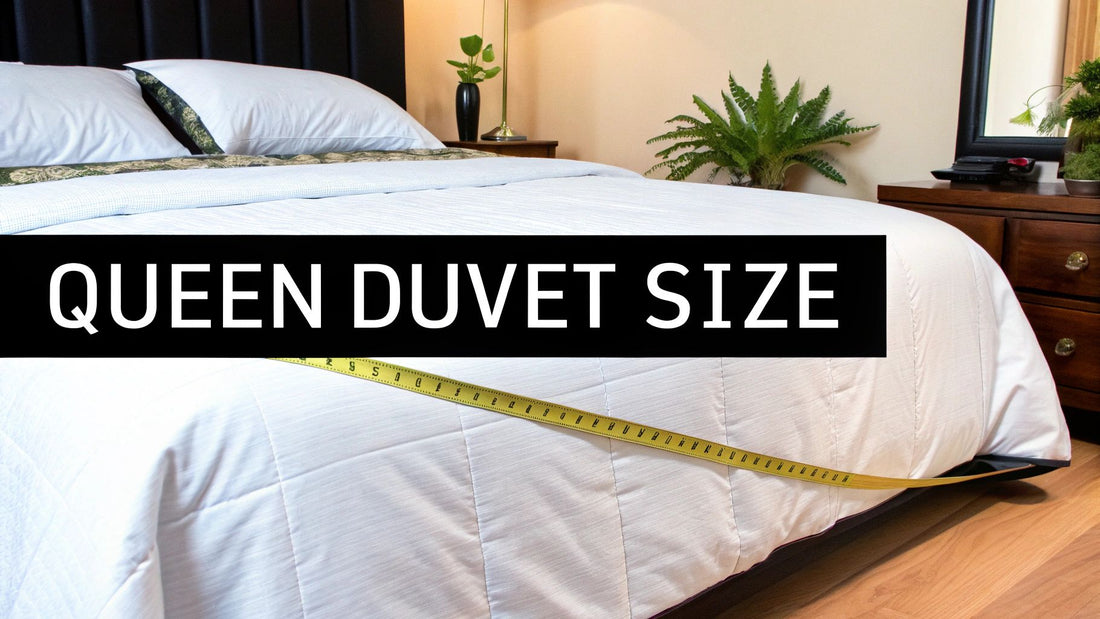When you’re on the hunt for new bedding, you’ll find that a standard queen duvet cover in New Zealand measures 210cm x 210cm. This perfectly square design is made to snugly fit a standard queen duvet inner, which shares the exact same dimensions.
Understanding NZ Queen Duvet Cover Sizing
Getting that perfectly made bed look all comes down to the relationship between your mattress, your duvet inner, and the cover itself. The key thing to remember is that your duvet and its cover are always meant to be larger than your mattress.
This intentional size difference is what gives you that lovely drape over the sides of the bed—what we call the "overhang." It’s this extra fabric that makes a bed look so inviting and feel incredibly cosy.
Kiwis certainly don't skimp on quality when it comes to bedding. The New Zealand duvet cover market is expected to reach a massive NZ$122.72 million in revenue by 2025, which just goes to show how much we prioritise a comfortable and stylish bedroom.
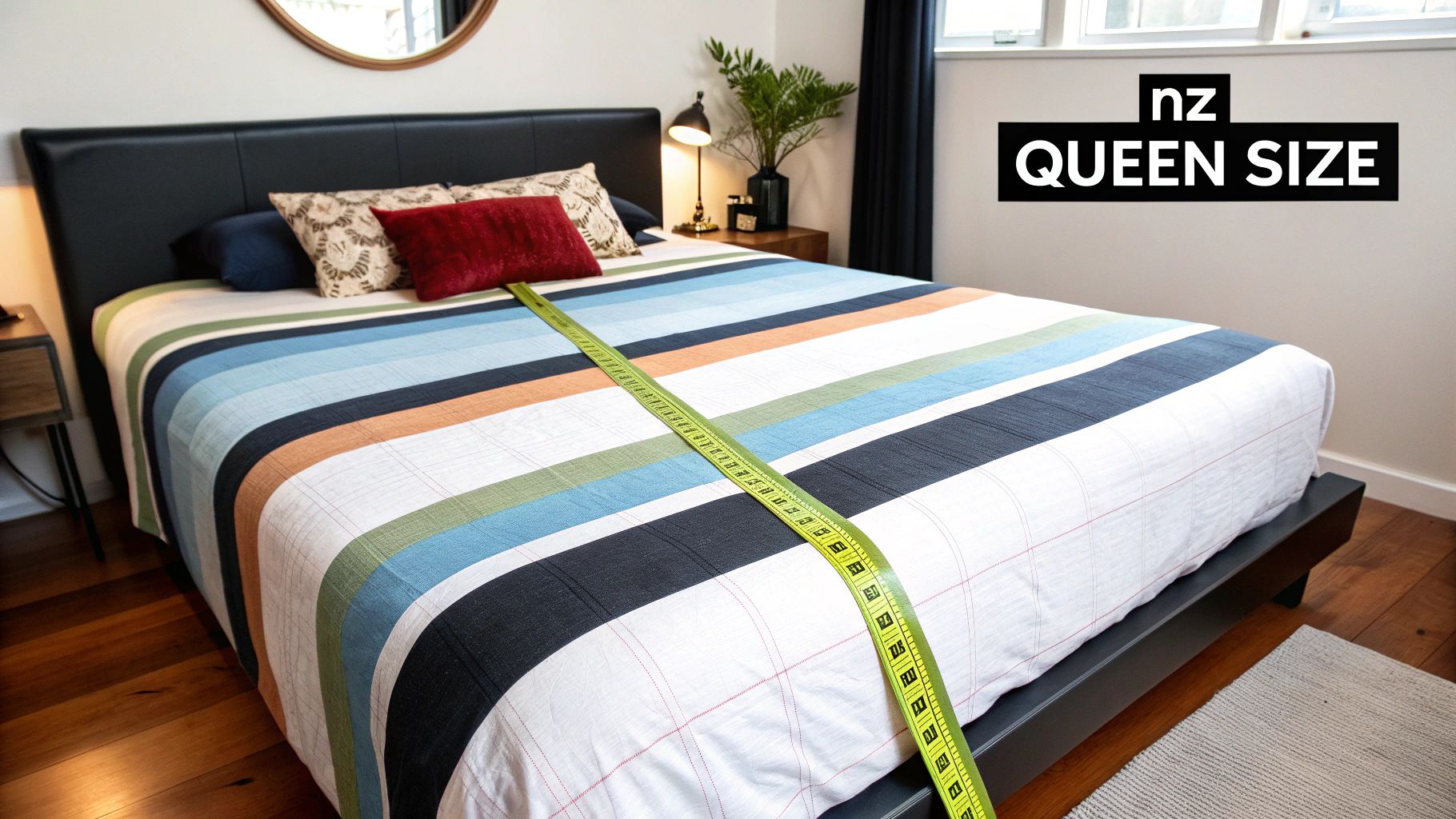
The Importance of a Good Overhang
So, why does that overhang matter so much? It’s not just for looks. A generous drape hides the mattress and bed base, giving your entire bedroom a tidier, more luxurious feel. Think of it as the finishing touch that pulls the whole room together. You can see this principle in practice with products like a Queen Tencel Lyocell Fibre quilt cover set, which are designed to create that beautiful cascade.
To get a clearer picture, let's break down the typical NZ measurements.
Queen Bed Dimensions at a Glance (NZ Standards)
This table shows you how the different elements of your queen bed work together.
| Item | Typical Dimensions (cm) |
|---|---|
| Queen Mattress | 153cm x 203cm |
| Queen Duvet Inner | 210cm x 210cm |
| Queen Duvet Cover | 210cm x 210cm |
As you can see, the square duvet provides a significant overhang on all sides of the rectangular mattress, ensuring full coverage and a plush look.
Getting the sizing right is the secret to achieving that hotel-quality bed at home. If you want to dive deeper into how measurements vary across different bed sizes, take a look at our complete guide to NZ duvet cover sizes.
Why a Queen Is Not Always a Queen in Bedding
Ever bought a new queen duvet cover, brought it home, and discovered it fits completely differently to your last one? You're not going crazy. It’s a common frustration, a bit like how a "medium" t-shirt can vary wildly from one clothing shop to the next.
While there is a general standard for bedding here in New Zealand, it's more of a guideline than a strict rule. This gives brands a bit of wiggle room to decide what "queen" means for their specific product line. These seemingly tiny variations, often just a few centimetres, can make a huge difference in how the duvet cover actually looks and feels on your bed.
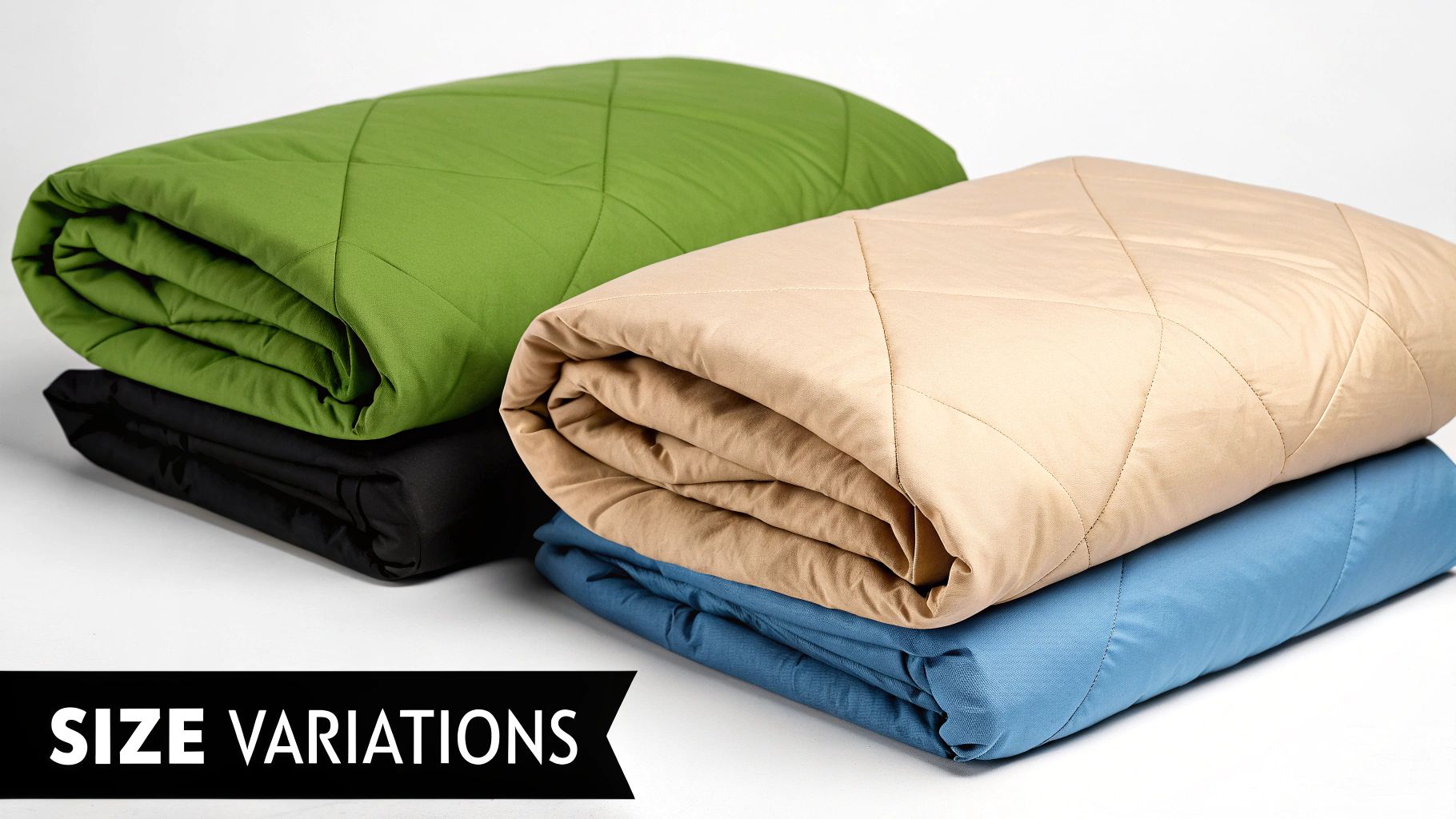
Unpacking the Sizing Differences
So, where do these discrepancies come from? It usually boils down to a couple of things: the realities of manufacturing and deliberate design choices.
- Manufacturing Tolerances: When you’re working with huge bolts of fabric, tiny shifts during cutting and sewing can happen. Good brands keep this to a minimum, but slight differences are just part of making textiles.
- Intentional Design Choices: Some brands want their linen covers to have a generous, drapey look, so they’ll deliberately cut them larger. On the other hand, a company going for that crisp, hotel-style aesthetic might make their covers snugger for a sharp, tailored fit.
The lesson here is simple: never just trust the "queen" label. Always, always check the specific measurements on the packaging. That one extra step will save you the headache of a duvet cover that’s too baggy or too short.
Getting your head around this little industry quirk is the key to shopping smarter. When you start looking past the label and focus on the actual numbers, you can find a queen duvet cover that not only fits your duvet inner perfectly but also gives you the exact style you’re after for your bedroom.
How to Measure Your Duvet for a Perfect Fit
To find the perfect queen duvet cover, you first need to know the exact size of your duvet inner. Guessing is a recipe for a bad fit, so grabbing a tape measure is the most important thing you'll do. It's a quick and simple process that takes all the guesswork out of your purchase.
The best way to start is by laying your duvet inner on a large, flat surface—the floor is usually your best bet. Make sure it's spread out completely, smoothing out any lumps or bunched-up bits to get an accurate reading.
Taking the Measurements
Ready to measure? Just follow these simple steps for a foolproof result.
- Measure the Width: Pull the tape measure from the left edge straight across to the right edge. Write this number down.
- Measure the Length: Now, do the same thing from the top edge down to the bottom. Record this number too.
- Measure Twice: It’s an old rule for a good reason. Double-checking your numbers helps you catch any small mistakes.
The real secret here is to trust your tape measure, not the label. A duvet labelled "queen" can sometimes shrink or stretch slightly after use and washing. The dimensions you measure yourself are the only ones that truly matter for getting that perfect fit.
The picture below shows the standard dimensions for a NZ queen duvet inner, which is likely what you'll be measuring.
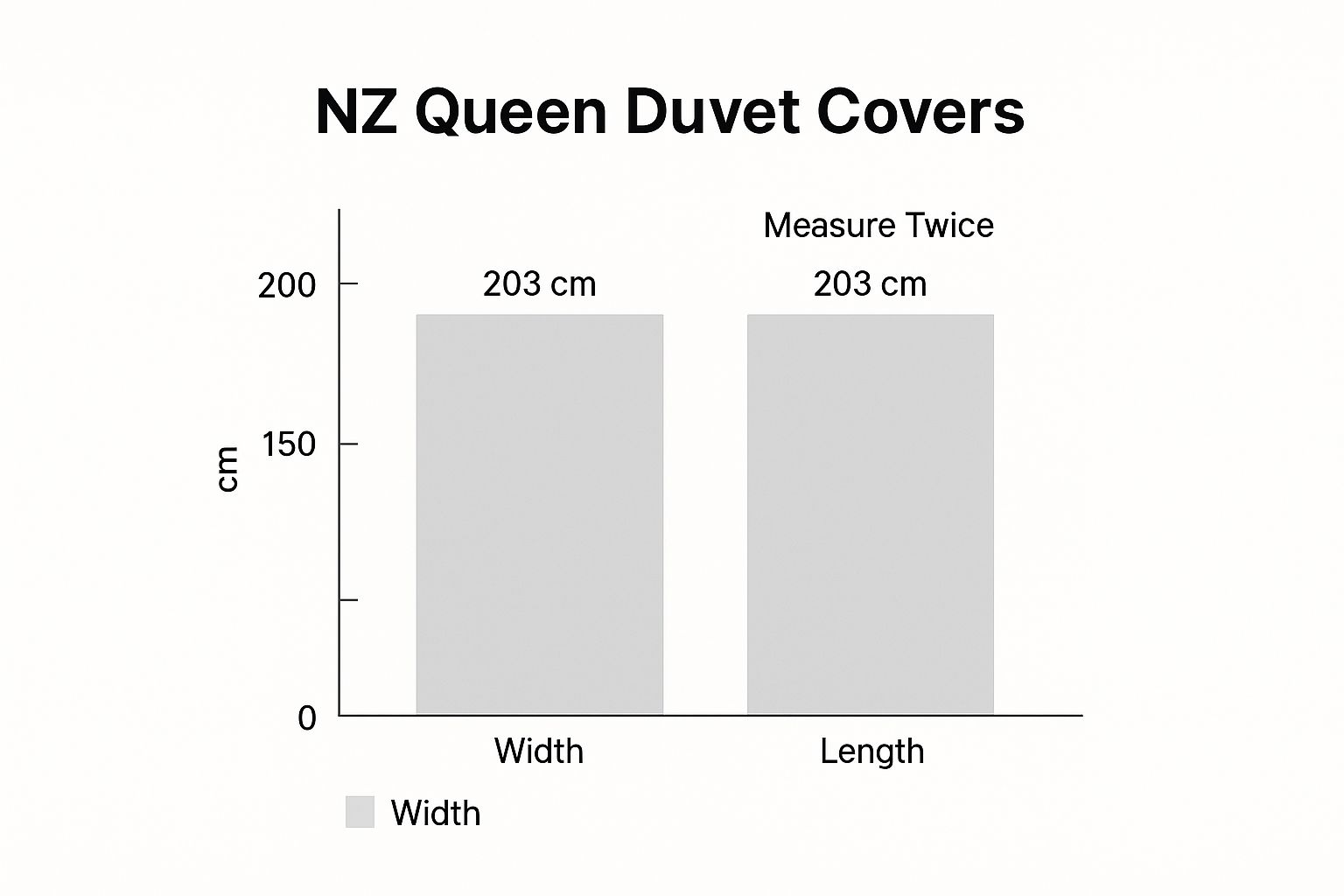
As you can see, queen inners are typically square, which is why getting both the width and length right is so important. When you have these exact numbers in hand, you can shop with total confidence.
For a complete rundown of all sizes, have a look at our guide to duvet measurements in NZ.
Finding the Perfect Drape for Your Bed
Getting that lush, "just-jump-in" look for your bed isn't just about picking the right colour or pattern. The real secret? It’s all in the drape—how much of the duvet cover hangs over the sides of your mattress. The right amount of overhang can be the difference between a bed that looks perfectly polished and one that feels a bit… off.
The biggest player here is the total height of your bed, which is your mattress plus any toppers you’ve added. A slim, modern mattress and a deep, plush pillow-top mattress will wear the same duvet cover very differently. That extra mattress depth eats into the duvet's width, leaving you with less fabric hanging down the sides.
So, you've got to decide what kind of vibe you're going for. Do you love a neat, tidy look where the duvet just kisses the bottom of the mattress? Or are you dreaming of a cosy, billowy bed with a generous drape that almost puddles on the floor?
Matching Overhang to Mattress Depth
While your personal taste is what matters most, it helps to understand how your mattress depth affects your choice of queen duvet cover size. To get that beautiful, even overhang on a deep mattress, you'll need a wider duvet than you would for a slimmer one. It’s a bit like a tablecloth—the thicker the table, the longer the cloth needs to be to drape properly.
Let's break it down. A standard 210cm wide queen duvet on a 25cm deep mattress gives you about 28.5cm of overhang on each side. But if you put that same duvet on a chunky 40cm mattress, that overhang shrinks down to just 20cm per side. That small difference can make the duvet look like it’s floating on top, rather than dressing the bed.
The goal is to strike a beautiful balance. You want enough drape to fully cover the sides of your mattress for a clean, intentional look, but not so much that it's all bunched up on the floor.
To make it easier to picture what you need, here's a quick guide to help you match your duvet overhang to your mattress.
Recommended Duvet Overhang by Mattress Depth
| Mattress Depth | Recommended Overhang Per Side | Resulting Look |
|---|---|---|
| 20-25cm (Slim Profile) | 30-40cm | A clean, tailored appearance that neatly covers the mattress. |
| 26-35cm (Standard) | 35-45cm | A classic, inviting drape with a touch of luxury. |
| 36cm+ (Deep/Pillow-Top) | 40-50cm+ | A plush, opulent style with a generous and cosy cascade. |
In the end, it’s all about finding that sweet spot between the practical measurements of your bed and the bedroom style you want to create. Get the drape right, and your bed will instantly become the stunning centrepiece of the room.
How Fabric Choice Affects the Final Fit
You've measured your duvet and double-checked the label, but there's one more piece to the puzzle that has a huge impact on the final fit: the fabric itself.
It’s a bit like buying a new pair of jeans. A pair of rigid, raw denim will fit completely differently from a pair with a bit of stretch, even if they’re technically the same size on the tag. Bedding is no different. Different materials react to washing, drying, and general use in their own unique ways.
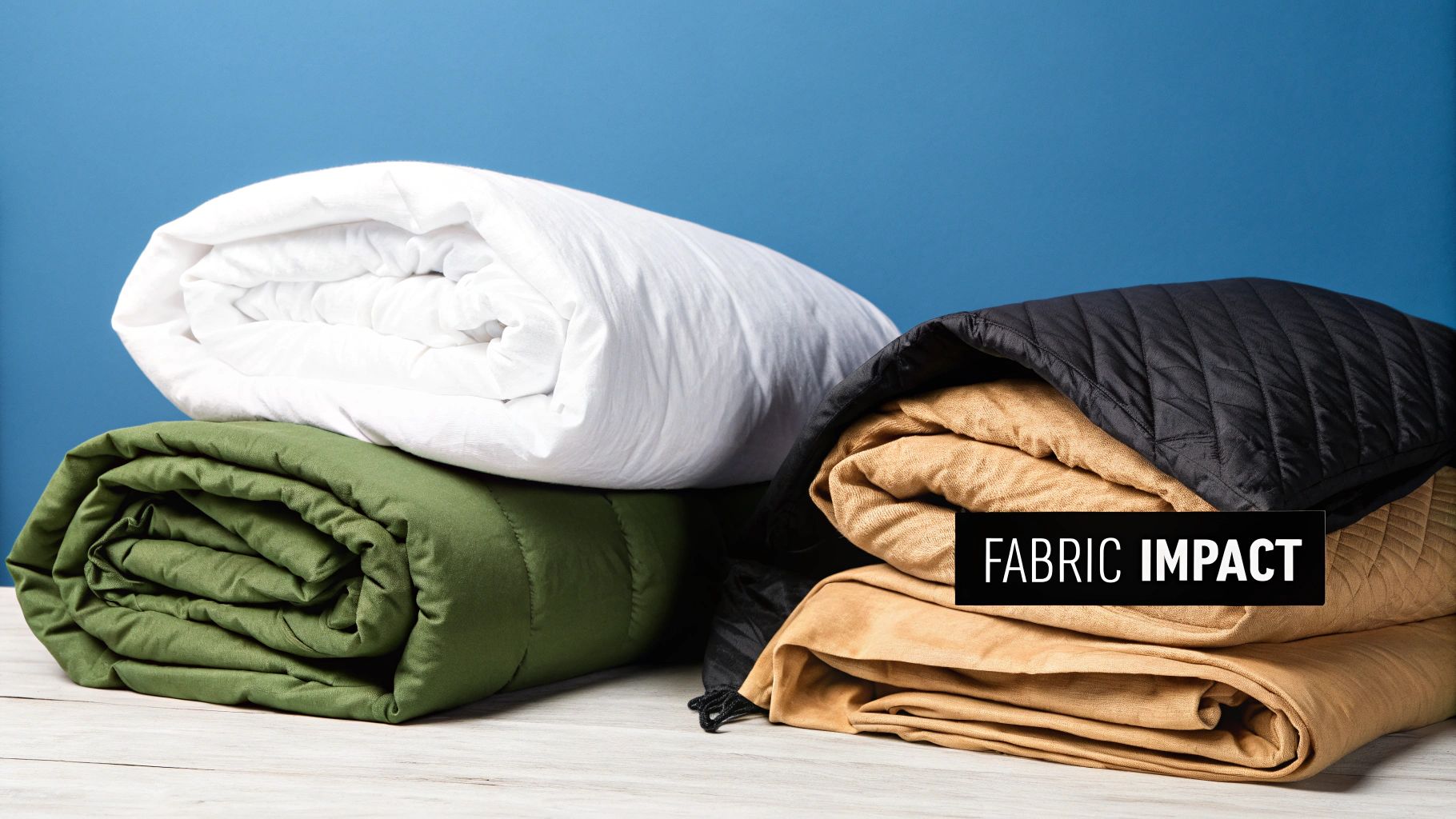
Natural fibres like cotton and linen feel amazing and breathe beautifully, but they’re also known to shrink a little, especially in the first couple of washes. Good-quality brands know this and often account for it, cutting their covers a fraction larger than the standard 210cm x 210cm to make sure you get a perfect fit once the fabric has settled in.
On the other hand, synthetic materials and poly-cotton blends are generally much more stable, holding their shape and size with more consistency over time.
Understanding Fabric Behaviour
This is why paying attention to the care label is about more than just washing instructions. It's your guide to keeping your bedding looking and fitting just right.
- Natural Fibres (Cotton, Linen): These can be prone to a bit of shrinkage. Keep an eye out for pre-shrunk labels if you want better size stability right from the get-go.
- Synthetic Fibres (Polyester, Microfibre): These are highly resistant to shrinking, so you can expect a very consistent fit wash after wash.
While many of us Kiwis will always love the feel of natural fibres, it's interesting to see how trends are shifting. The New Zealand market for cotton bed linen recently saw its value drop to around $3.8 million, a noticeable dip that points to changing tastes. You can read more about these bedding trends over at IndexBox.
Ultimately, knowing how your chosen fabric will behave is the secret. A gorgeous, rumpled linen cover might be designed with a little extra room to achieve that relaxed, drapey look. A crisp percale cotton cover, however, is often made for a sharper, more tailored finish.
Thinking about the material helps you choose a queen duvet cover that not only fits perfectly on day one but continues to look fantastic for years to come. And if you’re a fan of linen's unique texture, our guide to caring for linen duvet covers in NZ has some more specific advice for you.
Still Have Questions About Queen Duvet Sizes?
Even with the measurements sorted, a few practical questions always seem to come up. Let's tackle some of the most common ones so you can feel totally confident when choosing your next queen duvet cover. This is the final piece of the puzzle to becoming a true bedding guru.
Can I Use a Double Duvet on a Queen Bed?
You can, but you probably shouldn't if you're aiming for that plush, well-styled look. A standard double duvet in New Zealand is smaller than a queen, which means you'll miss out on that lovely, generous drape over the sides of the bed.
Putting a double duvet on a queen mattress will almost certainly leave the sides of your mattress exposed. It tends to make the whole bed look a bit small and unfinished. For the best look and, more importantly, the best snuggling experience, it's always worth matching your duvet size to your mattress.
How Do I Stop My Duvet Inner from Bunching Up?
It’s one of the great bedding frustrations, isn't it? Waking up to find your duvet inner has migrated into one giant lump inside the cover. This happens simply because the inner has too much room to move around. Luckily, the fix is easy.
Most quality duvet covers have little ties or loops sewn into each of the four corners. These are designed to be tied to corresponding loops on your duvet inner, anchoring it securely in place. No more midnight wrestling match with your bedding!
When you're shopping for a new queen duvet cover, make checking for corner ties a priority. It's a small detail that makes a world of difference in keeping your bed looking neat and feeling comfortable.
If your current duvet or cover doesn't have them, you can sew some on yourself, or find special duvet clips that do the same job.
Are Australian and NZ Queen Sizes the Same?
This is a really important one, especially if you're shopping online. While we're neighbours, New Zealand and Australia do have some different ideas about standard bedding sizes.
When it comes to the duvet cover itself, the news is good:
- NZ Queen Duvet Cover: The standard is a perfect square at 210cm x 210cm.
- Australian Queen Duvet Cover: The standard is also typically 210cm x 210cm.
So far, so simple. The confusion usually creeps in with the mattresses. An Australian queen mattress is often a bit wider than ours here in New Zealand. So, while the duvet covers are generally identical, it’s always smart to double-check the specific product dimensions before buying from an Aussie retailer. Rely on the centimetres, not just the "queen" label, to guarantee you get the perfect fit and avoid any surprises.
At The Foxes Den, we know that true comfort starts with the perfect fit. Explore our curated collection of premium linen and Supima® cotton bedding, designed with timeless elegance and exceptional quality to transform your bedroom into a sanctuary. Discover your perfect duvet cover today at https://www.thefoxesden.co.nz.


